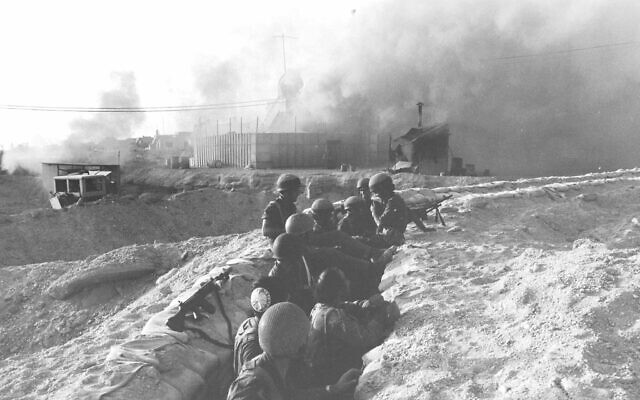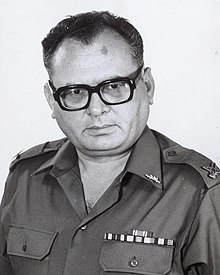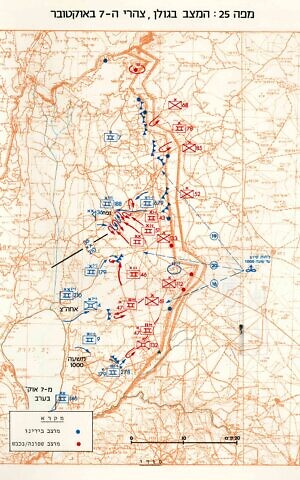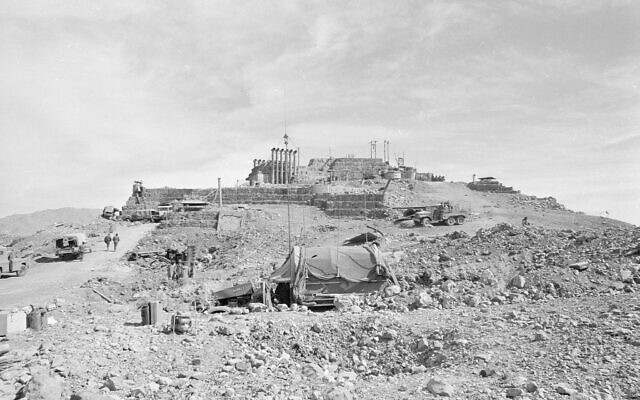The Defense Ministry on Sunday launched a website hosting dozens of newly declassified documents, images, videos and other files from the 1973 Yom Kippur War, in honor of the conflict’s 50th anniversary later this year.
Among the documents being published for the first time were Military Intelligence assessments from the month prior to the conflict, later submitted to a commission that investigated the war; the diaries of Brig. Gen. Yoel Ben-Porat, head of the Israel Defense Forces’ signals intelligence unit, which described the intelligence failures in the leadup to the war; and eyewitness accounts of the fall of the Hermon outpost during the first day of the conflict.
In all, the website (Hebrew link) comprises 15,301 photographs, 6,085 documents, 215 videos, 40 audio recordings and 169 maps related to the Yom Kippur War, some of which have only recently been cleared for publication.
“The Yom Kippur War website was established in order to tell the story of the generation of the war, to commemorate the bravery of the fighters, and to be an official platform for passing down the legacy of the war to future generations,” the ministry said in a statement.
IDF’s final intel assessment hours before conflict
Excerpts provided by the ministry from the final IDF Military Intelligence assessment before the war, on October 6, 1973, at 9 a.m., showed how Israel was still unsure that Egypt and Syria would launch a surprise attack just hours later.
Get The Times of Israel's Daily Edition by email and never miss our top stories
“It seems to us that Egypt and Syria are coordinating their steps… The armies of Egypt and Syria are essentially ready for war, the forces near the borders are of unprecedented strength. If a decision is made at a strategic level to start fighting, then they will be able to do so from the current preparation without the need for additional preparations… On the one hand, we assume that the strategic echelon in Egypt and Syria is aware of the lack of chance of success in war and the risks involved. On the other hand, we are witnessing broad military preparations and we also have news about trends [indicating the] start of a war in the immediate timeframe,” the now-declassified assessment read.

An Israeli military position in Ras Sedr, in the Sinai Peninsula, during a sandstorm or under bombing on October 6, 1973 during the Yom Kippur War. (Michael Tzarfati/Defense Ministry Archives)
A previously published assessment from one day earlier stated that “the likelihood that the Egyptians intend to renew fighting is low… The likelihood of an independent Syrian action (without the Egyptians) remains low.”
Many other IDF Military Intelligence assessments and documents, later presented to the Agranat Commission, were released by the Defense Ministry on the new website.
Mossad knew a week earlier: ‘War imminent’
An entry in Ben-Porat’s diary lamented that the Mossad spy agency knew a full week in advance that Egypt was planning to launch a surprise attack on Yom Kippur 1973, but did not pass the information on in an orderly and explicit way to prime minister Golda Meir’s office or other officials.

Yoel Ben-Porat (Wikipedia)
“Already on Friday at 2:30 [a.m.] (36 hours before the fighting), a telegram arrived at the Mossad encrypted with code words that were ambiguous, but two words from it were completely clear: war imminent,” the declassified diary entry read.
“Except for the three (the head of the Mossad, the office manager, and the head of Military Intelligence), no one heard about the information — not the prime minister, not the defense minister, not the chief of staff,” Ben-Porat, who headed the SIGINT (signals intelligence) unit, added.
Tales from the fall of the Hermon outpost
The Defense Ministry also published the eyewitness accounts of then-lieutenant Gadi Zidover, commander of the Hermon outpost in the Golan Heights, and sergeant. David Nahliel, a Golani soldier, as they managed to escape the post during the Syrian invasion on the first day of the war. Their accounts described the outpost’s lack of readiness for war and the battle in which many of the post’s soldiers were killed or captured. Zidover had retreated from the outpost with Nahliel and a number of other soldiers as it was being invaded.
“We heard shouting in Arabic and bullets [hitting] the doors. This is when the force began to panic… The people blocking the openings were barely carrying a single magazine, no belt, no grenades, and no weapons. After they would shoot a few rounds, and maybe hit some Syrians, they would be eliminated,” said Zidover.

A map showing the military situation on the Golan Heights front during the Yom Kippur War, on the afternoon of October 7, 1973. (Defense Ministry Archives)
“I had two magazines, the rest were without weapons and without ammunition. I had one grenade… I saw that there was no point in fighting… I started gathering people by shouting,” he said.
In Nahliel’s account, he was asked whether or not the outpost’s troops were told to be on alert. “We knew that there was an alert, but we certainly didn’t think about a war, maybe a day of fighting. It was not clear to us that there was a war,” the soldier said.
“On Saturday at [2 p.m.] there was a shelling of the outpost. I happened to be near the observation post together with the commander of the post, and the Golani platoon commander. The observation post took a direct hit and we all flew back,” Nahliel said.
“We opened fire on them. I saw that a Syrian guy was shooting at the anti-aircraft position… and the position was hit. Right as the [heavy machine gun operator] started shooting back, because he was a little bit visible, he took a burst of gunfire to the heart. He fell and shouted, ‘I’ve been hit.’ I and the platoon commander grabbed him and pulled him inside,” the soldier continued.
“All the men of the outpost were actually Air Force and Communications Corps. They had firearms, but they did not have ammunition for war. They did not know how to fight and were also afraid,” he added.

The IDF’s Hermon Outpost in the Golan Heights on October 20, 1973, during the Yom Kippur War. (Defense Ministry Archives)
The ministry said it would continue to update the site with new content on the war as they are declassified.
The 1973 war ended via a final ceasefire on October 25, with Israel retaining control of the Sinai Peninsula and Golan Heights, which it had conquered in the Six Day War.
Over 2,500 Israeli soldiers died and thousands more were injured in the fighting, along with thousands of Egyptian, Syrian, and Iraqi dead and wounded troops.


